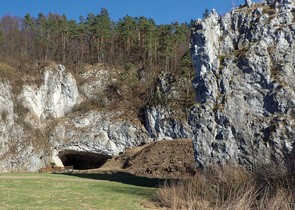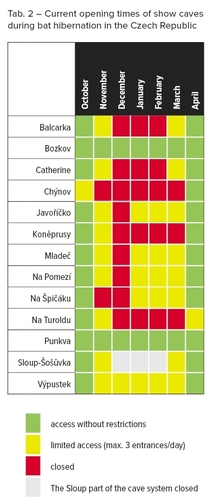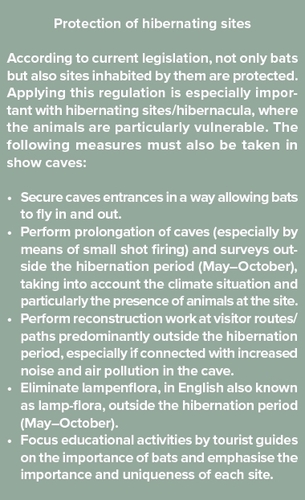The Journal is published by the Nature Conservation Agency of the Czech Republic in cooperation with the Cave Administration of the Czech Republic, the Krkonoše Mts. National Park Administration, the Bohemian Forest Mts. National Park Administration, the Podyjí National Park Administration and the The Bohemian Switzerland National Park Administration. It has been published since 1946.
cs / en
Nature Conservation 2022 — 25. 5. 2022 — Research, Surveys and Data Management — Print article in pdf
Show Caves as Important Hibernacula of Bats in the Czech Republic

The International Union of Speleology (UIS) has declared 2021 as the International Year of Caves and Karst (IYCK). Unique phenomena in our landscape have therewith received deserved attention. Of more than 2,460 karst caves in the Czech Republic, 14 are show caves. All of them are fully legally protected according to national law and in addition, most of them are also protected as important bat hibernation sites (hibernacula) at the European level pursuant to the European Union’s legislation, namely the Habitats Directive. An important pillar of nature conservation is regular monitoring of Specially Protected animal species, and this also is the case in caves.
Significance of monitoring
Long-term monitoring of bats has been per- formed according to a unified method at all known hibernation sites of importance, with emphasis on minimal disturbance of hibernating animals, since the 1990s. The data gathered substantially help determining changes in distribution and abundance of bats, including a possible clarification of the causes of these changes. The monitoring is coordinated and carried out by members of the Czech Bat Conservation Society (CBCS), in collaboration with the Nature Conservation Agency of the Czech Republic and other volunteers, also in show caves and operated by the Czech Cave Administration. Only the specific Zbrašov Aragonite Caves are unsuitable for bat hibernation with regards to the high temperature (14–16 °C) and relatively high concentrations of carbon dioxide (CO2) in some parts. The remaining caves, however, belong to the largest bat hibernation sites in the Czech Republic.
These are the following caves (in descending order by number of hibernating individuals – average over the past ten years): the Javoříčko Caves 5,417; Sloup-Šošůvka Caves 2,282; Na Pomezí Caves 902; Na Turoldu Cave 638; Balcarka Cave 268; Koněprusy Caves 260; Kateřina/Catherine Cave 242; Punkva Caves 149; Výpustek Cave 148; Na Špičáku Cave 137; Chýnov Cave 99; Mladeč Caves 50; and the Bozkov Dolomite Caves 25. Except for the last one, all mentioned caves are Sites of Community Importance (SCI) within the EU Natura 2000 network, under which bats are a subject of protection.
Between 2011 and 2020, each year 12–14 bat species were recorded in show caves in the Czech Republic. Over the entire period, 16 species hibernated there. The highest species richness (15 species) was recorded in the Sloup-Šošůvka Caves, but 5 species, each represented by a single specimen, hibernated there only once. Due to the very similar temperature (mostly 7–9 °C) and air humidity in all the caves, it is not a great surprise that three species dominate, i.e. the Lesser horseshoe bat (Rhinolophus hipposideros), Greater mouse-eared bat (Myotis myotis) and the Geoffroy’s bat (Myotis emarginatus) there. However, this statement does not apply in full, because the Geoffroy’s bat does not hibernate in show caves in Bohemia, and in the Chýnov Cave the Lesser horseshoe bat is even completely missing.
The proportion of animals from hibernating sites in show caves in comparison with other regularly monitored sites in the Czech Republic can be regarded as very significant for the three dominant species, as can be seen from Tab. 1. More than a third (35.6%) of lesser horseshoe bats and nearly a third (30.4%) of Geoffroy’s bats hibernate at only 14 sites! However, the show caves have small significance for other species important in Europe, e.g. the Barbastrelle (Barbastella bar- bastellus), Bechstein’s bat (Myotis bechsteinii) and the Pond bat (Myotis dasycneme).
In the Czech Republic, really rare hibernators in the show caves recorded in the monitoring period were Myotis bechsteinii (15 individuals), the Serotine bat Eptesicus serotinus (8 individuals), the Northern bat E. nilssonii (8 individuals), Myotis dasycneme (2 individual), and truly sporadically also the Parti-coloured Vespertilio murinus and Pipistrellus pipistrellus (only one individual each).
Wat about development trends?
Trends in the development of bat population sizes in show caves in the Czech Republic cannot be generalised. Only three caves, Na Turoldu, Balcarka and Výpustek, showed a permanent increase in numbers of hibernating animals during the monitoring period. This was in all three cases linked to the growing Lesser horseshoe bat’s numbers. Generally, the largest number of animals was counted in 2017 (11,478 individuals, 13 species), but surprisingly only three caves, Chýnov, Javoříčko and Mladeč, reached their maximum in that year. How to explain the fact? The number of hibernating bats is influenced by many factors, the most important being possibly inappropriate interventions in maternity colonies. All three most numerous hibernating species usually form such colonies in the attics of buildings. A less important factor is subnational/ regional climate conditions, which significantly influence food supply in the time of birth and rearing the young.
Similarly, the influence of visitors on bat populations in the winter season cannot be clearly assessed because the conditions vary from cave to cave. In the Na Špičáku and Na Turoldu caves, where most hibernating animals are practically within reach of visitors, the presence of people can be very disruptive. In the Javoříčko Caves, about two thirds of the bats stay at the visitor route/path, even though they could choose a place away from it. However, most of them are at a great distance from the visitors and the site is moreover, due to difficult access in winter, not much sought after by visitors. On the other hand, in the Punkva and Mladeč caves, most hibernators are found off the visitor route/ path, so that they are practically not disturbed.
Tab. 1 – Numbers of the selected bat species at hibernating sites in show caves in the Czech Republic (data CBCS 2011–2019)
|
|
Accessible caves |
Other hibernating sites monitored in the Czech Republic |
||
|
Species |
Total number |
Proportion (%) |
Total number over the period |
Proportion (%) |
|
Rhinolophus hipposideros |
73,611 |
35.6 |
133,362 |
64.4 |
|
Myotis myotis |
12,114 |
14.2 |
73,207 |
85.8 |
|
Myotis emarginatus |
4,405 |
30.4 |
10,093 |
69.6 |
|
Barbastella barbastellus |
698 |
2.4 |
28,485 |
97.6 |
Tab. 2 – Current opening times of show caves during bat hibernation in the Czech Republic
Main results
So does cave access in winter affect the size of bat populations? It may have – somewhere more, elsewhere less. Do caves need to be closed to visitors completely in the winter?
Some need to be, other ones not. Each site needs to be assessed individually according to its dimensions, potential number of visitors in the time of bat hibernation, and possibilities of alternative shelters. Only in winter can regular visitors come ‘within reach’ of these very interesting animals, develop a positive relationship with them and understand their important role in the ecosystem. They can spread the acquired information and ideas further on and therewith also help protect rare animals which we pay a visit in their dormitories. ■
- - -
Intro Fig. 1 Entrance of the Nicová Cave in the Sloup-Šošůvka cave system, where the largest bat hibernation site of the Moravian Karst is situated. © Jiří Šafář



